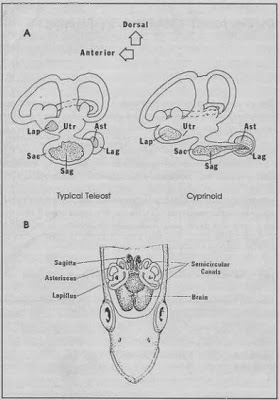by Ed Kluender, guest blogger
Ask a fish its age or where it's been and what it ate for lunch, and chances are it couldn't tell you. It could probably hear your question, though, with the help of its inner ear bones, called otoliths. Otoliths are one of the most useful tools in a fish biologist’s toolbox. When removed and studied, otoliths can reveal a fish’s age, growth rate, and some history of where it’s been.
Ask a fish its age or where it's been and what it ate for lunch, and chances are it couldn't tell you. It could probably hear your question, though, with the help of its inner ear bones, called otoliths. Otoliths are one of the most useful tools in a fish biologist’s toolbox. When removed and studied, otoliths can reveal a fish’s age, growth rate, and some history of where it’s been.
Otoliths are similar to the bones in human inner ears. They are three pairs of small stone-like structures, called the lapilli, sagittae, and asterisci (singular: lapillus, sagitta, asteriscus). Otoliths are suspended in fluid-filled sacs, and as in humans, help with balance and orientation.
 |
| Inner ear structure and otolith location in typical teleost fish. The sagittae and lapilli are the two typically used for aging fish. Source: David Secor, University of Maryland. |
Otoliths grow throughout a fish’s life, and are formed by layers of calcium carbonate that are laid down at different rates, depending on metabolic rate. Slower metabolic rates during the winter form denser layers (the opaque zone), while high metabolic rates in spring and summer form less dense layers (the translucent zone). This makes the otoliths look like an onion, with the opaque bands corresponding to slower growth appearing as dark rings.
Because each opaque band represents a year of growth, scientists can use otoliths to estimate a fish’s age. Then, using the fish’s total length and proportional diameters of each opaque zone to the total diameter of the otolith, we can estimate the fish’s length at any age and thus its growth rate.
The size and shape, or morphology, of otoliths can reveal more information about population structure and environmental conditions. Otoliths have even been useful in recent climate change research . Some research even shows that fish can hear quite well with their otoliths, and sense the direction and nature of the sound.
Otoliths contain all of this information, even in larval fishes. The metabolism of a larval fish fluctuates on a daily basis in response to water temperature and daylight. At night, metabolism slows, which causes the formation of a minute opaque zone. With the aid of a microscope, we can look at the tiny otoliths – some as small as 0.1 mm – and count the number of daily rings to estimate the day at which the larvae hatched. After that, we can estimate the fish’s daily growth rate since hatching.
This information is very valuable to scientists and land managers. Because the habitats and water conditions in which fish spawn, incubate, and rear their young are very important to successful recruitment into the population, care must be taken to keep that habitat suitable for optimum growth rate.
Seemingly simple actions like diverting water for agriculture or power plant cooling result in the water returning to its source with a very different temperature, turbidity, and chemistry that can prevent successful reproduction.
Please see an earlier post by The Fisheries Blog for more information about otoliths.
Be sure to like The Fisheries Blog on Facebook, follow us on Twitter (@FisheriesBlog), and feed the fish at the bottom of the page.
Please see an earlier post by The Fisheries Blog for more information about otoliths.
Be sure to like The Fisheries Blog on Facebook, follow us on Twitter (@FisheriesBlog), and feed the fish at the bottom of the page.
References
Campana, S. E. 1999. Chemistry and composition of fish otoliths: pathways, mechanisms and applications. Marine Ecology Progress Series. 188:263-297
Popper, A. N. and Z. Lu. 2000. Structure-function relationships in fish otolith organs. Fisheries Research. 46:15-25




No comments:
Post a Comment
Please leave a professional comment to create discussion about this topic. We reserve the right to remove any comment.